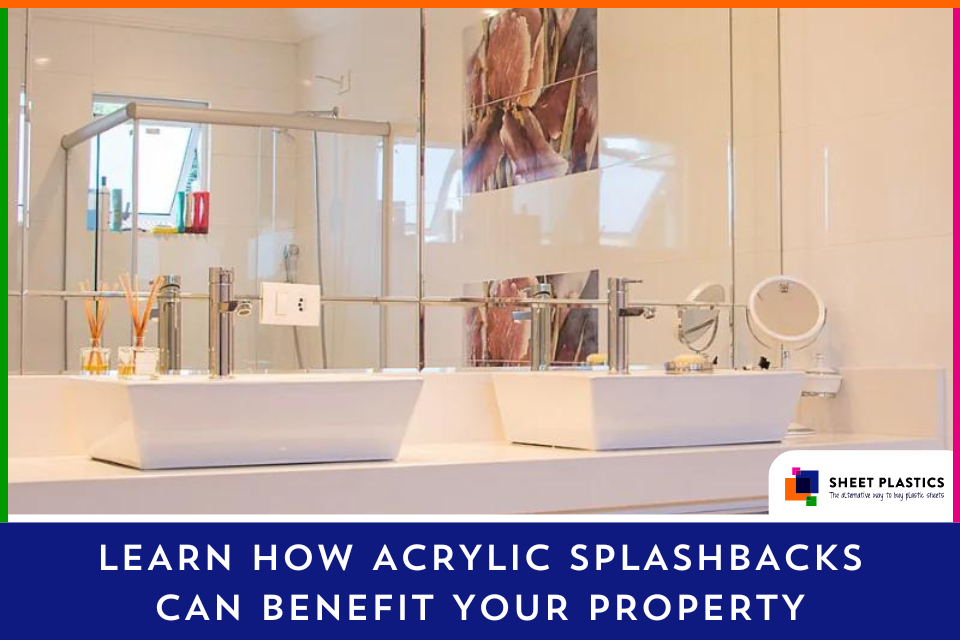What Is An Acrylic Splashback?

Acrylic splashbacks are used to cover the walls generally in kitchens replacing tiles and protecting your walls from food, water and general grease marks. Please see below some images of acrylic splashbacks after installation.
WHAT COLOURS DO ACRYLIC SPLASHBACKS COME IN?
At Sheet Plastics, we offer over 30 different colours and effects that you can choose from.
ARE ALL YOUR COLOURS GLOSS?
We offer a large selection of acrylic sheets in different effects and styles, we also offer a frosted finish which is proving popular for Kitchen Splashbacks. You can view our range of Frosted Acrylic Sheets here
WHY SHOULD I USE AN ACRYLIC SPLASHBACK OPPOSED TO A GLASS SPLASHBACK?
Glass splashbacks are more expensive, will shatter, are susceptible to chipping and cracks and you are limited to colour selections in glass. Glass is much heavier than acrylic and more difficult to install.
Acrylic is a cost effective, impact resistant, lightweight, easy to clean and maintain and easy to install product.
CAN I USE ACRYLIC BEHIND THE HOB IN THE KITCHEN?
No you cannot use acrylic behind the hob due to the fire rating of the acrylic sheet. People would normally use acrylic for the walls of the kitchen and behind the hob use steel, glass or our range of other materials mainly being our range of aluminium composite sheets. You can view our range of aluminium Composite products here
CAN I FIT MY ACRYLIC SPLASHBACK TO ANY SURFACE?
Because our range of acrylic splashbacks are produced using some of the best acrylic sheets from around the world our sheets are extremely easy to put to the wall and are easily attached to almost any surface.
WHAT THICKNESS SHOULD I USE FOR MY ACRYLIC SPLASHBACK?
We would recommend using 5mm thickness which will make the splashback more rigid but many people purchase from us daily 3mm and it is very rare we hear of any issues regarding installation or the rigidity of the panel.
MEASURING FOR AN ACRYLIC SPLASHBACK.
Once you have decided what area you are looking at covering it is best to draw out on a piece of paper the area that is going to be covered and also include any parts that will require cut outs example sockets, wall units or cooker isolators.
If you are fitting your acrylic splashback to a surface between your worktop and a cupboard it is recommended to leave a 1mm top and bottom to ensure the panel fits but also ensures minimal movement. Also check that all worktop surfaces and cupboards are all level. These small gaps can be filled in later with sealant as you will want to prevent moisture from running down the walls and behind the splashback from the top.
Now measure the total width and height of acrylic needed and then mark it on your plan (remember to leave 1mm top and bottom). Where you need to cut around any cupboards measure this also, again leaving a slight gap for movement.
When it comes to sockets and switches a gap between 3mm – 5mm is left around the cut out socket face sits inside it. Sealant can then be applied around the inside of the gap to seal the socket and the edge of the acrylic.
Now you have the measurements our advice would be to get the experts at Sheetplastics.co.uk to machine your splashback to your exact specification or you can attempt to cut the materials and finishing yourself.
Cutting Acrylic for your Splashback
It is possible to cut your own splashback but it is recommended that your DIY skills are well above average.
Drills
You should only use drill bits made specifically for drilling acrylic. This are normally pre-ground twist bits. When drilling, make sure that you don't push the bit through the acrylic as it can burst through the bottom and cause sections to splinter off. Support the drill hole with a piece of timber and drill down into this to help stop any damage of this kind
Saws
Again, there are many specialist blades made for this job, so please make sure you use one of these. You can cut with a hand saw if you wish but using a jig saw set on the fastest cutting speed will produce the cleanest, most uniform cut. Never force the blade through the material as it can overheat and cause the cut edge to melt. Also make sure that vibrations are kept to a minimum as these can cause cracks and splits. Laying the acrylic on top of cardbaord while you cut it can help with this.
When you are cutting any straight lines with a jigsaw it is recommended to clamp a wooden batten or similar along the line you are cutting so the base plate of the jigsaw can follow it ensuring a straight line as a final result.
Cutting
When you received your sheet of plastic, it will have come with a protective film on both sides of the sheets. It is important that you leave this on until the sheet until it is ready to be secured to the wall.
Cutting acrylic can be difficult and it is important that you do not let the acrylic overheat or it will melt, and also reduce vibration as much as is possible.
Our recommendation is when cutting out holes for sockets is mark the exact area that needs cutting and use a jigsaw to cut out. In order to get the blade in you can drill some large holes in each corner and then cut along the line from hole to hole. When drilling the initial holes make sure you drill them on the inside of the cutout. Be careful to follow the marked out lines otherwise your panel will not fit and you will either have to trim down bits which can be difficult with acrylic or you could even cut completely wrong and have to order the piece of acrylic again.
Assuming you have done all the above correct you should now have an acrylic splashback cut and ready to be fitted. Once you have cut outs in your acrylic you need to move it carefully, we would recommend getting some extra help to position your acrylic in place to make sure it fits. If you do need to make any small adjustments you can use a small file.
Smoothing Edges
Now time to smooth some of the edges, because you have used non specialist tools you will more than likely have some jagged and sharp edges.
To remove some of these edges you can use the flat edge of suitable small half round file but during this be very careful as now any damage to the sheets may be irreversible. The filing will remove the majority of major burrs but it is best to use some wet and dry paper to give the final finish.
When using the wet and dry paper, this will need to be done in several stage using several different grades of paper.
For the first pass, use something like a 100 - 120 grit paper, get a small bowl and fill with clean water. Dip the paper in the water and get it nice and wet. Wrap the paper around a small, flat piece of wood (to use as a rubbing block) and then proceed to rub the paper along the cut edge, keeping the block and paper flat to the edge of the acrylic. Again, do not apply much pressure and stop occasionally to clean the plastic shavings off the paper and also to wet the paper. Continue for several passes, up and down the full length of the
For the second, pass swap the previous paper for something a little finer now, around 400 grit should be fine. Get the paper wet and then wrap around the block and repeat the above passes over the edge, stopping to clean the paper and re-wet periodically
For the final pass, this time use a very fine paper. Something around 600 - 1000+ grit should be just right. Repeat the previous steps, checking the edge between passes to check progress. Once the edge is pretty much back to its smooth, shiny state you should be done. Again, check your passes regularly as you don't want to go too far and cause more damage.
Once you have got your cuts as smooth as possible using the wet and dry paper you can finish off by using T-Cut or similar. Dab a small amount on an old cloth and using your finger rub it along the edge. Using a clean cloth rub off misty residue to reveal your smooth and shiny edge.
Fitting Your Acrylic Splashback
Now it is time fit your acrylic splashback to the wall, before doing this you need to make sure that the wall you are fitting the splashback to is completely flat and has no bumps or uneven parts as this could affect the final finish. With all the prep work done now do a couple of tests to ensure that your splashback fits, using the extra pairs of hands place your splashback against the wall as if you were fitting to make sure that it all fits and all holes and cut outs fit.
Before applying any bonding to rear of the splashback, remove the protective from the rear of the sheet and clean the entire area with an Ispropyl Alcohol to remove all traces of dirt, dust, grime and grease, once this has been done you can start using your chosen method of installation.
There is a couple of methods of adhering your splashback to the wall, one being strong double sided tape and the other being silicon adhesive. www.sheetplastics.co.uk sell both of these products. If you are using double sided tape or silicon adhesive we recommend that you purchase with your splashback a sample of the same colour and test in advance of the application as some adhesives and tapes can be visible through some of the colours and in particular lighting will affect if the tape or adhesive can be seen. If you are using double sided tape we recommend that you put this around all edges of the splashback and also in horizontal lines spacing them evenly ensuring they are no more than 300mm apart.
If you are using silicon do not put too close to the edge of the sheet as it will seep out when you apply to the wall, as with the tape run beads of silicon horizontally across the sheet and space evenly ensuring they are no more than 300mm apart.
When you are ready to go, position the base of the splashback exactly where it needs to be in terms of position and angle at 45 degree from the bottom and start to push the sheet into the wall working upwards. The splashback will normally adhere to the wall very quickly but you may have to apply some pressure for a while. Total curing times if using adhesives is usually around 24 hours but check with the manufacturers instructions for confirmation.
Once cured and totally stuck remove the protective film from the sheet and admire your new plastic splashback.
Acrylic Splashbacks at Sheet Plastics
NOTE: All of the above is general advise and should not be taken as a full instruction guide on how to measure, fabricate and install your splashback. Each application will vary with circumstances.
For the fabrication of your splashback we recommend to get this pre fabricated by Sheet Plastics and then you either install yourself or seek the help of a local tradesman for the installation.








